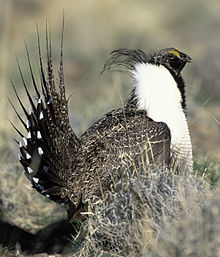Our website is made possible by displaying online advertisements to our visitors.
Please consider supporting us by disabling your ad blocker.
Grouse
| Grouse Temporal range: Early Miocene to recent
| |
|---|---|

| |
| Male sage grouse Centrocercus urophasianus | |
| Scientific classification | |
| Domain: | Eukaryota |
| Kingdom: | Animalia |
| Phylum: | Chordata |
| Class: | Aves |
| Order: | Galliformes |
| Family: | Phasianidae |
| Subfamily: | Phasianinae |
| Tribe: | Tetraonini Leach, 1819 |
| Genera | |
|
Pucrasia[note 1] and see text | |
| Synonyms | |
|
Tetraonidae Vigors, 1825 | |

Grouse /ɡraʊs/ are a group of birds from the order Galliformes, in the family Phasianidae. Grouse are presently assigned to the tribe Tetraonini (formerly the subfamily Tetraoninae and the family Tetraonidae), a classification supported by mitochondrial DNA sequence studies,[2] and applied by the American Ornithologists' Union,[3] ITIS,[4] International Ornithological Congress,[5] and others.[6][1]
Grouse inhabit temperate and subarctic regions of the Northern Hemisphere, from pine forests to moorland and mountainside,[7] from 83°N (rock ptarmigan in northern Greenland) to 28°N (Attwater's prairie chicken in Texas).[8]
The turkeys are closely allied with grouse, but they have traditionally been excluded from Tetraonini, often placed in their own tribe, subfamily, or family;[2][8][9][10] certain more modern treatments also exclude them.[11][12] Later phylogenomic analyses demonstrated conclusively that they are sister to the traditionally-defined grouse, and they, along with the somewhat earlier-diverging koklass pheasant, may be treated as grouse (i.e., as basal members of the Tetraonini).[1] This is reflected in some more recent circumscriptions.[6][10]
- ^ a b c Kimball, Rebecca T.; Hosner, Peter A.; Braun, Edward L. (2021-05-01). "A phylogenomic supermatrix of Galliformes (Landfowl) reveals biased branch lengths". Molecular Phylogenetics and Evolution. 158: 107091. Bibcode:2021MolPE.15807091K. doi:10.1016/j.ympev.2021.107091. ISSN 1055-7903. PMID 33545275. S2CID 231963063.
- ^ a b Cite error: The named reference
Gutierrezwas invoked but never defined (see the help page). - ^ Cite error: The named reference
AOUlistwas invoked but never defined (see the help page). - ^ Cite error: The named reference
ITISwas invoked but never defined (see the help page). - ^ "Taxonomic Updates – IOC World Bird List". Retrieved 2021-08-01.
- ^ a b Cite error: The named reference
Boydwas invoked but never defined (see the help page). - ^ Cite error: The named reference
EoBwas invoked but never defined (see the help page). - ^ a b Cite error: The named reference
Fireflywas invoked but never defined (see the help page). - ^ Cite error: The named reference
ssdwas invoked but never defined (see the help page). - ^ a b "turkeys, grouse, pheasants, and partridges articles-Encyclopedia of Life". Encyclopedia of Life. 27 April 2013. Retrieved 27 August 2023.
- ^ "Phasianidae Horsfield, 1821". GBIF. Retrieved 27 August 2023.
- ^ Persons, Nicholas W.; Hosner, Peter A.; Meiklejohn, Kelly A.; Braun, Edward L.; Kimball, Rebecca T. (2016). "Sorting out relationships among the grouse and ptarmigan using intron, mitochondrial, and ultra-conserved element sequences". Molecular Phylogenetics and Evolution. 98. Elsevier BV: 123–132. Bibcode:2016MolPE..98..123P. doi:10.1016/j.ympev.2016.02.003. PMID 26879712.
Cite error: There are <ref group=note> tags on this page, but the references will not show without a {{reflist|group=note}} template (see the help page).
Previous Page Next Page


